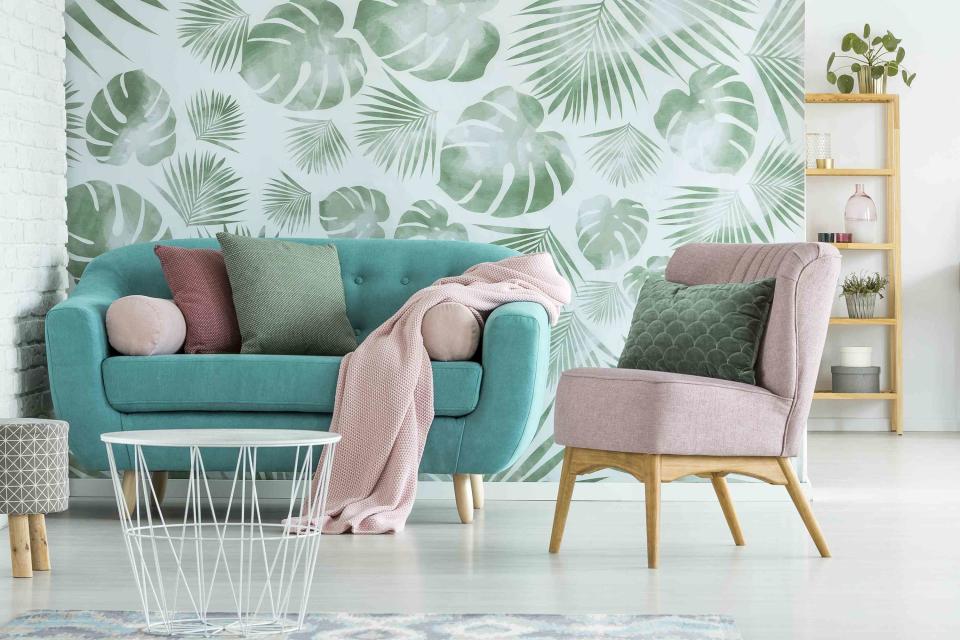10 Tips for Installing Peel-and Stick-Wallpaper, According to the Pros
It's not as hassle-free as it looks on TikTok.

Katarzyna Bialasiewicz/Getty Images
Want to instantly makeover a room in just one weekend? TikTok would have you believe that all it takes is installing a few rolls of peel-and-stick wallpaper and voila—your bedroom, bathroom, or dining room has a completely different look. But is the process as easy as social media would have you think it is?
We talked to several design professionals to get their advice on the best way to install peel-and-stick wallpaper, and it turns out that the task isn't quite as simple as TikTok makes it out to be. Luckily, these pros offered their advice on how to avoid a wallpaper disaster, and provided step-by-step guidance for the best way to install peel-and-stick wallpaper yourself—just like a seasoned TikTok user. Keep reading for some helpful hints from the pros!
:
Patience Is Essential
As with many home improvement projects, patience is key here. Interior designer and HGTV star Francesca Grace installed peel-and-stick wallpaper in her guest room and breakfast nook. Admittedly, she’s not the most patient person, so if you’re like Grace, know this going into the project. If you don’t have the best DIY skills or easily become frustrated, you may want to consider professional installation instead.
Measure Properly
Once you’ve found a wallpaper you love, don’t click “add to cart,” just yet. It’s crucial to properly measure your walls first. “Count your panels and make sure you have the proper amount before you start. After a hard day's work, you'd be devastated to have an unfinished job because of an oversight,” says Molly Borman Heymont, founder of decor and peel-and-stick wallpaper brand, Housewife Essentials.
Steer Clear Textured Walls
“Only apply to flat smooth walls,” shares Grace. While you can apply peel-and-stick wallpaper to textured walls, just be aware that it’s more difficult, and probably won’t turn out as good as you want it to.
Clean and Prep Walls First
Grace suggests cleaning the wall you're working on and letting it dry before applying the wallpaper. “I’d go over the wall with a damp cloth to get rid of any dust or dirt, which can also prevent the wallpaper from sticking,” she explains.
:
Apply the Wallpaper Uniformly
Heymont notes you can start applying the wallpaper from the top or bottom, as long as you’re consistent throughout. “It is absolutely critical to line up your panels every single time from the same starting point. I personally find it easiest from the top, but others are more comfortable starting up against the floor,” she shares.
Avoid Air Bubbles
There’s nothing more frustrating than dealing with air bubbles, but you should expect it in the process. “Depending on the size of the air bubble, you may be comfortable piercing the bubble and letting the air out that way,” suggests Heymont.
If you’re uncomfortable going that route, she recommends slowly peeling the paper back in order to release the bubble.
Pick a Wallpaper Color That Blends With Your Wall
TikToker Joanna Hawley, who installed Chasing Paper's Cowboy Toile in her bathroom, reveals that the process was even easier than she anticipated it would be. “I didn't realize it would be so easy to adjust the placement until it was just right,” she notes.
However, Hawley learned an important lesson along the way, “Make sure the color of the wall you are covering is similar in color to the background of the wallpaper print. There's nothing worse than installing a dark wallpaper on a white wall and seeing peeks of the white at the edges of the wallpaper.”
Get Your Tool Box
It's also critical to have the right tools on hand. “I highly recommend a measuring tape, level, smoothing tool, utility knife with a fresh blade, and a step ladder,” adds Hawley.
:
And an Extra Set of Hands
For the average non-DIYer, it makes sense to ask a pal for help. Tara Kowalke, who installed peel-and-stick wallpaper on two accent walls as well as in her kitchen, notes that it wasn't a perfect process, but it was doable with the help of a friend. “It’s much easier with at least one other person,” she says.
Plan Ahead For Tricky Spaces
Kowalke also recommends lining up pieces vertically and horizontally if you can’t use a full strip from ceiling to floor, especially in places like kitchens where appliances and countertops can make installation more difficult. Still, she felt the entire process was worth it. “It was much easier than I thought and adds so much to a room for very little investment, without damaging your wall,” she concludes.
For more Real Simple news, make sure to sign up for our newsletter!
Read the original article on Real Simple.

 Yahoo Movies
Yahoo Movies 
